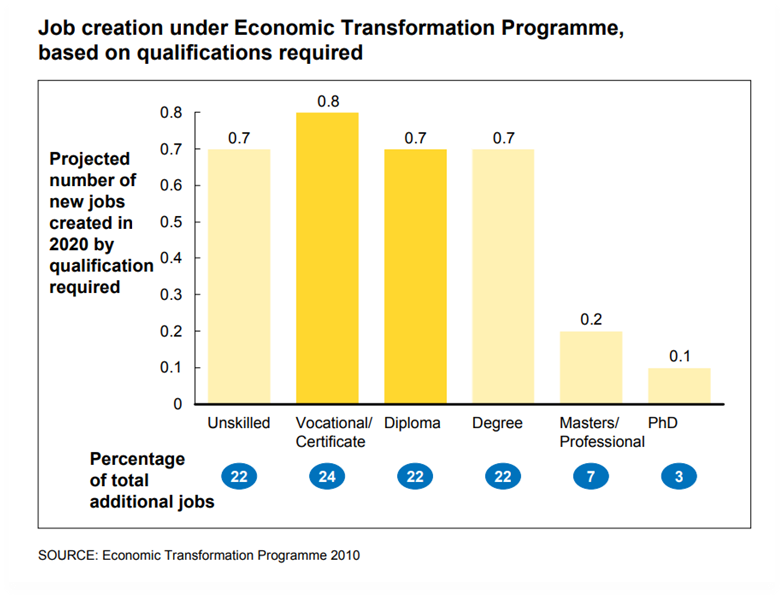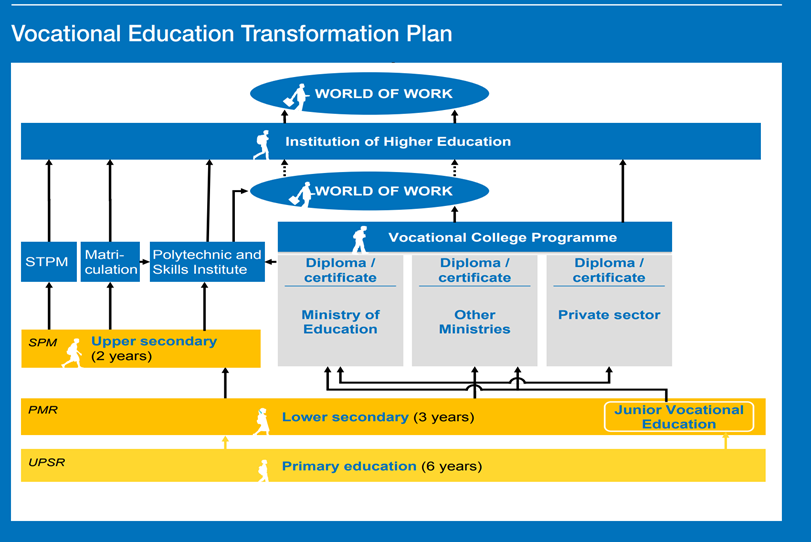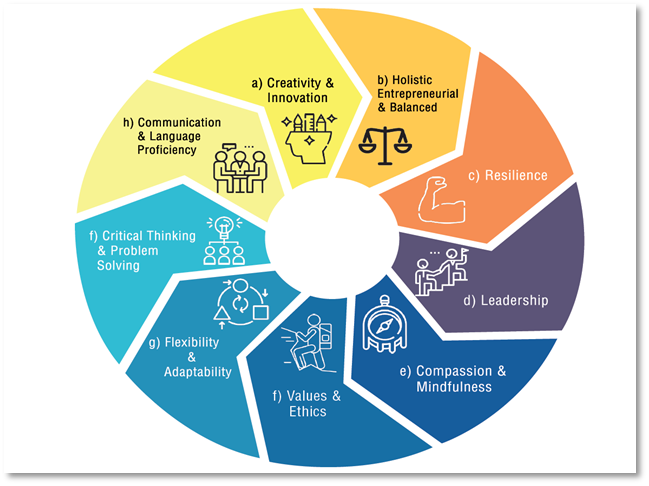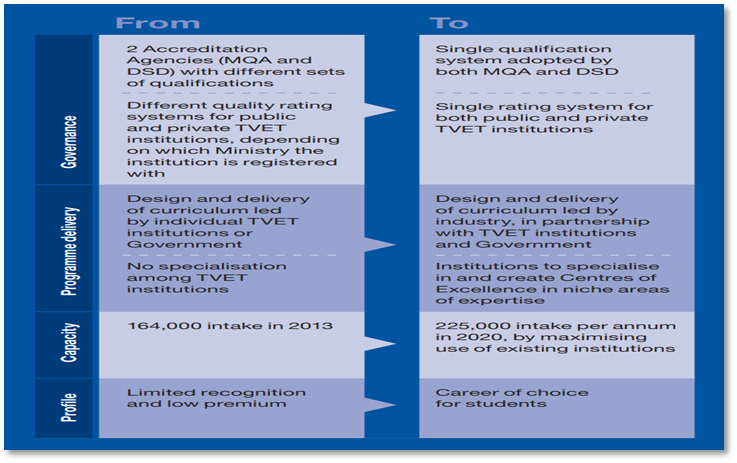Abstract
Malaysia plans to prepare its human resources for the Fourth Industrial Revolution in order to reduce the current consumption gap in a number of key industries, including those that are driving the country’s economic transformation. The government has acknowledged the importance of the TVET sector in developing skilled workers and generating revenue to support Malaysia in reaching its goal of becoming a high-income nation. Because of its potential to raise the employment rate, TVET will be essential in luring highly skilled workers. TVET not only ensures employment, but also has the potential to make an employee into a business owner. The article provides a synopsis of the Future Proof Talent initiative and TVET transformation programmes. It also offers a survey of studies, reports, and articles published up to the present day on the topic of TVET reform in Malaysia and other countries. The purpose of this research is to propose a certain aspect of strategic planning that can be implemented as an alternative way to meeting the challenge of successfully generating professionals who are prepared for the future.
Keywords: TVET transformation, future ready professional, challenges, skills of Malaysian graduates.
1 Introduction
The importance of technical and vocational education and training to economic growth, job creation, and worker satisfaction cannot be overstated. The need for a trained and educated labour force in the emerging global economy has prompted governments around the world to undertake educational reforms (Cong & Wang 2012). Spees (2018) claims that countries around the world are working hard to increase their workforce quality and size through vocational training in order to capitalise on the booming labour market. It is of paramount importance in developing nations where there are large numbers of young, unskilled workers. After seeing the success that Germany had with its TVET curriculum, other developed countries, such as Spain and Portugal, implemented their own TVET programmes. TVET has been identified in Malaysia’s 11th Plan 2016-2020 as a key factor in achieving the country’s goal of becoming a high-income nation by 2020 (MOHE 2016). The aim is to make sure there are enough people with a variety of skills to keep up with the expansion of the economy (Cong & Wang 2012). Access to education and skills set training, raising awareness, elevating the perception of TVET, and bolstering collaboration with industries for greater recognition were all given considerable attention (Rasul et al. 2015). At the end of the day, these changes and initiatives were not enough to discuss how to reform TVET into a better system, especially if the country wants to compete internationally in this era of globalisation. Since 2005, apprentices in Malaysia have benefited from the National Dual Training System, which places them in both the classroom and the workplace (Affero & Hassan 2013). NDTS is not just about learning to code; it also focuses on developing one’s interpersonal and organisational abilities. Therefore, it is important to improve TVET governance, engage key education stakeholders, and ensure that graduates are in line with the country’s vision. This paper will focus primarily on Malaysia’s future alternative transformation education plan for technical and vocational education and training (TVET) and future talent.
1.1 Vocational Education Pathway
Vocational training is designed to help those who need to master specific skills. The vocational stream puts a greater emphasis on students’ future careers than the technical stream, which helps them get ready for college. The number of students attending vocational secondary schools has dropped over the past few decades due to a lack of available spaces. However, demand for graduates with vocational training is soaring and is expected to rise further. A shortage of over 700,000 skilled workers was reported in manufacturing, agriculture, and construction by the Ministry of Human Resources in 2008. Of the estimated 3.3 million new jobs created by The National Key Economic Area (NKEA), at least 46% will call for some sort of vocational certificate or diploma, while only 22% will necessitate a four-year college degree (Figure 1). More than 50,000 annual slots in vocational schools are needed to meet this demand. The STEM skills learned in most vocational programmes are essential to providing the 60:40 gender balance in Malaysia’s workforce that the country’s economy demands (MOE 2013).

In addition to meeting this demand, it is also difficult to maintain quality standards. Which of the following are reasons why graduates won’t be ready to meet industry needs: (i) not enough qualified teachers and the lack of a curriculum that is recognised by industry; (ii) not enough collaboration with industry and training on the job? Interviews with parents and students have shown that they were not well informed about career paths and options. In response to these concerns, the Ministry came up with the Vocational Education Transformation Plan, which aims to improve graduate-level training for skilled jobs. As part of this plan, the Ministry made vocational education available to lower secondary students through the Junior Vocational Education (PAV) programme and improved the existing vocational education programme for upper secondary students through the Vocational College (KV) programme. Under the Vocational Education Transformation Plan, the Ministry wants 10% of each group of students in upper secondary to be vocational students by 2015. The Ministry thinks that by 2020, this number will go up to 20%. As the plan is put into action, students, parents, and industry stakeholders give initial feedback (MOE 2013).
1.2 Vocational Education Transformation Plan
In response, the Ministry is transitioning vocational secondary schools, or Sekolah Menengah Vocational (SMV), into vocational colleges in an effort to improve the upper secondary vocational education programme (KV). These academic institutions must offer a revised curriculum and certification at the certificate and diploma levels, known as the Malaysian Vocational Diploma or Diploma Vokasional Malaysia (DVM). The allocation of credit will adhere to national and international norms. Similar to Pendidikan Asas Vocational (PAV), the current diploma curriculum consists of 70% technical vocational skills and 30% general academic education (PAV). In addition, the curriculum includes a six-month industry orientation in which numerous industry stakeholders were consulted to ensure the project adhered to industry standards and best practices. To enhance graduate education, the Ministry has developed a vocational transformation plan (Figure 2).
It has two components: (i) Vocational Education for Juniors (PAV), which is for the Lower Secondary level, and (ii) Vocational College programme, which is for the Upper Secondary level. In 2012, the Ministry of Education tested out a vocational path for 13- to 15-year-olds in 15 schools. This programme lets students get skills certification up to level 2 of the Malaysian Skills Certificate or Sijil Kemahiran Malaysia (SKM) at the age of 15, instead of the age of 17 that had been set before. Bauer and Gessler’s (2016) studies also showed that students can start TVET at a younger age, which is similar to systems in Austria and Germany, which are both known for having strong vocational education systems. The Ministry is working on a new curriculum that will be a mix of 70 percent training in job skills and 30 percent learning about academic subjects. In 2013, this initiative reached its completion of all phases of implementation.

2 Future Talent
The Framing Higher Education 4.0: Future-Proof Talent is a guide for the public and private education sectors to meet the needs of 4IR. The new technologies of the Fourth Industrial Revolution (4IR), such as artificial intelligence, the Internet of Things, digitalisation, and automation, have forced Malaysia to change its Higher Education system to prepare students for jobs that require new skills. This change could cause education and business to rethink how to improve, reskill, and scale up talents in the workplace to work together with humanistic values and smart machines. The Malaysia Education Blueprint 2015–2015 and the Malaysian Ministry of Education’s vision were used to create this document as a guide for people who have a stake in higher education (MOHE 2018).
Hajar Halili (2019) noted that, as we enter the era of Industrial Revolution 4.0, it is important to consider how best to train the next generation of citizens to embrace technological progress without losing sight of the human element. As a result, Future Proof Talent is a strategic plan to accommodate Malaysia’s economic and growth development, ensuring that all of our graduates will integrate 4IR skills or technologies into an ever-changing ecosystem. The stakeholder in higher education anticipates that universities will do more than simply improve students’ learning to better equip them for the workforce.
For a very long time, people have argued over whether universities should focus on creating graduates with marketable skills or on serving as incubators for new ideas. The pressure on universities to remain relevant in the face of economic instability and dwindling employment prospects has increased dramatically as attention has shifted to the Fourth Industrial Revolution (4IR) (Shuib 2019). The Malaysian Ministry of Education has developed a framework to prepare students for the 4IR phenomenon in light of the aforementioned problem. Colleges and universities should encourage student creativity and originality by providing stimulating classroom environments. As can be seen in Figure 3, the framework identifies nine skill sets that today’s Malaysian graduates need to develop in order to become the future’s professionals.

3 Component of Strategic Planning
A plan is required to improve the technical skills of the country, including offering academic programmes that are based on the needs of the business world and produce graduates who are ready to work. In this section, we will talk about the parts of the Malaysian government, institutions, and students that will be the focus of the work.
3.1 Malaysia Government Objectives
During the 11th Malaysian Plan, the government wants to improve human resource development by changing TVET to meet industry needs for 60% of the workforce. For this project to succeed, people will need skills related to TVET. Malaysia’s annual intake for TVET will have to increase from 164,000 in 2013 to 225,000 in 2020. The tenth Malaysia Plan’s efforts to integrate and expand access to better TVET saw the number of new students rise from 113,000 in 2010 to 164,000 in 2013. As stated in the 11th Malaysian Plan, the government will work more closely with the private sector to increase enrolment in TVET, improve the quality of programmes and institutions, and give the sector as a whole a better name and reputation. To support the Malaysia Blueprint’s counterpoint to optimising the vocational education transformation plan, which includes more collaboration between the public and private sectors, there are three important strategies for integrating TVET into the Education Malaysia Plan (EPU 2015):
3.1.1 Redesign the national qualification framework and coordinate quantifiable metrics between private and public TVET institutions to improve TVET governance.
Setting up a single system that will be used by both the Malaysia Qualification Agency (MQA) and the Department of Skills Development (DSD) will help the TVET sector be better coordinated and monitored.
3.1.2 Improving the quality and delivery of TVET programmes will make it easier for graduates to find jobs.
Using new partnership models that let industries take part in all stages of curriculum development and delivery, such as curriculum design and delivery, apprenticeships, internships, and work-based learning programmes, to help solve skills mismatches. Streamlining the National Dual Training System (NDTS), including expanding the 1MASTER NDTS to address specific areas of industrial development and industry needs and getting rid of duplicate and low-impact programmes.
3.1.3 Rebranding TVET
Rebranding TVET as a preferred delivery mechanism through strategic media campaigns that inform students and their families of the many rewarding professional and business opportunities available to them as a result of their TVET studies. Figure 4 depicts the Malaysian Qualifications Framework.

Participants in Adnan’s empirical research project were found to have been exposed to Industry 4.0 skills, Adnan et al. (2021). During their “summer camp” in Malaysia, they also learned and practised the ten requisite skills. Despite the fact that participants have been incentivised by their country to be ready for the advent of 4IR, they continue to struggle with uncertainty, unease, and a lack of preparedness as a result of the disruptions and unknowns that 4IR has introduced. There is no doubt that the governments of these ASEAN countries should play a more active role in preparing these young people for successful careers and shaping them into future-oriented and future ready workers.
3.2 Institutions
Human capital will be increased because approximately 60% of new jobs created under the 11th Malaysian Plan will require vocational and technical skills. The former Minister of Education, Dr. Maszlee Malik, has stated that it is the country’s vision to promote TVET as a first choice among students, rather than a secondary option. As a result, Malaysia needed to transition away from industry participation and toward partnership-based TVET, while simultaneously involving more industrial sectors to strengthen dual training programmes (Aziz 2019). According to research by Ashari and Rasul (2014), collaboration between TVET institutions and industry is crucial to achieving the desired results in terms of human resource development, thus meeting projected labour demands in the future. In fact, it is imperative that the Department of Skills Development (DSD) exerts maximum effort to attract business involvement in the National Dual Training System (NDTS). The TVET system should continuously incorporate cutting-edge workplace innovations to maximise student outcomes and the return on investment in their education (Omar et al. 2020).
Malaysia Blueprint Education (2015-2025) highlights the challenges posed by the disparity between graduates and industry. Public universities need to make sure that the programmes they offer produce graduates who are skilled, well-rounded, and fit the needs of the country’s job market. Along with this ideal, the Ministry of Education came up with other ideas for the Industry Revolution 4.0 (4IR) wave, such as Malaysia MOOC, 2u2i, APEL, Gap Year, CEO@Faculty, Malaysia English Assessment (MEA), and My E-Portfolio. These solutions are also part of the content that needs to be added to our current curriculum to ensure that students are competent and relevant in the learning age of the 21st century (Ujir et al. 2020). Grapragasem et al. (2014) found that many private companies are helping Malaysian college graduates find jobs. This is a great idea that shows how committed the institutions are to training high-quality skilled workers who can compete in the global market.
3.3 TVET Graduate
TVET is still seen as a secondary option, so low-achieving students tend to be the ones who enrol in vocational schools in developed and developing countries alike. TVET has a poor reputation compared to other areas of education in many countries. On the other hand, positive assessments of TVET education were found in reports from the same study’s countries that had developed TVET systems, such as Algeria, Morocco, and Tunisia (UNESCO-UNEVOC 2018). Both employers and workers are beginning to recognise the benefits of TVET, as demonstrated by the research of Subramaniam et al. (2020). In 2008, many people began to realise that 4IR was on the rise and would have far-reaching effects on the job market. Subramaniam et al. (2020) argue that everyone should be aware that TVET is available to anyone, regardless of their educational background. Those who are unable to acquire the necessary skills and knowledge in order to mature into responsible and useful members of society represent a squandering of human potential.
Students who have failed their secondary exams in Malaysia are required to attend a year of TVET courses of their choosing in order to retake the exams the following year. The Ministry of Education, Youth and Sports recommends that students be given the freedom to select the skills they want to learn in order to increase their engagement with TVET education and improve their exam performance (Subramaniam et al. 2020). According to research conducted by Dahalan et al. (2020), all parties involved in education have the opportunity to increase the number of students graduating who are prepared to launch their own businesses from select TVET institutions. Additionally, this will lessen college grads’ reliance on the current public and private sectors to find work. The Ministry of Higher Education reported in 2016 that only about 3% of all graduates actively engage in entrepreneurial activities (MOHE 2020). Despite the low numbers, TVET has demonstrated that those who complete the programme are capable of realising their full potential in accordance with their individual skills and preferences. The findings confirm that students’ interest in future employment opportunities is the primary motivator for enrolling in TVET programmes (Abdul-Aziz et al. 2020).
4 Conclusion
A strategic plan to strengthen TVET Malaysia includes the provision of private sector academic programmes to create graduates who are qualified to work in their respective fields after graduation. Hence, this study focuses on critical aspects such as the Malaysian government, institutions, and TVET students. Schools, both public and private, can now fulfil 4IR requirements with the help of Higher Education 4.0 Talent. As a result, the Malaysian Ministry of Education has developed a 4IR talent framework to ensure that all of our graduates will be able to integrate 4IR skills and technologies into a comprehensive and ever-changing work environment. As a result of the country’s current emphasis on TVET development, Malaysian students are being equipped to deal with problems that may arise in the future as a result of 4IR. When it comes to education, TVET goes above and beyond. It is the foundation of a country’s ability to set off a domino effect that boosts the economy.
TVET is essential for economic growth, employment expansion, and job quality. It is essential in developing countries with large numbers of young, unskilled labourers. The Technical and Vocational Education and Training (TVET) sector plays a vital role in Malaysia’s 11th Plan 2016-2020 to achieve its goal of becoming a high-income nation by 2020 (MOHE 2016). The document, originally written in 1988 and updated in 1996, argues that schooling is essential to every child’s development and has the power to teach the next generation of Malaysians the country’s founding ideals. Therefore, the goal of both the Higher Education 4.0 Talent document and the TVET transformation plan is to train individuals who can make significant contributions to national development so that the country can adapt to the digital revolution and thrive. It would be interesting for other researchers to look into TVET’s budgeting with an eye towards improving TVET education. In order for the nation to reach the level of a developed nation, it must allocate the appropriate budget for the sustainable development TVET programme. This would contribute to the improvement of the TVET sector.
References
Abdul-Aziz, S. N., Zulkifli, N., Nashir, I. M., & Karim, N. A. H. A. (2020). Pull and push factors of students’ enrolment in the TVET programme at community colleges in Malaysia. In: Journal of Technical Education and Training, 12, 1, 68–75.
Adnan, A. H. M., Rahmat, A. M., Mohtar, N. M., & Anuar, N. (2021). Industry 4.0 critical skills and career readiness of ASEAN TVET tertiary students in Malaysia, Indonesia and Brunei. In: Journal of Physics: Conference Series, 1793, 1, 1–12.
Affero, I. & Hassan, R. (2013). Issues and Challenges of Technical and Vocational Education & Training in Malaysia for Knowledge Worker Driven. In: National Conference on Engineering Technology, January 2013. Online: https://www.researchgate.net/publication/271702784_Issues_and_Challenges_of_Technical_and_Vocational_Education_Training_in_Malaysia_for_Knowledge_Worker_Driven (retrieved 05.01.2023).
Ashari, Z. H. M. & Rasul, M. S. (2014). Determining the Issues and Concern in Malaysia’s TVET Agency -Industry Engagement. 10th AASVET Conference 2014, 1–7. Bangi: Universiti Kebangsaan Malaysia.
Aziz, H. (2019). Getting industry to lead TVET. Kuala Lumpur: New Straits Times. Online. https://www.nst.com.my/education/2019/10/526383/getting-industry-lead-tvet (retrieved 28.09.2021).
Bauer, W. & Gessler, M. (2016). Dual Vocational Education and Training Systems in Europe: Lessons learned from Austria, Germany and Switzerland. In Eicker, F., Haseloff, G., & Lennartz, B. (eds.): Vocational Education and Training in Sub-Saharan Africa: Current Situation and Development, 48–66.
Cong, S. & Wang, X. (2012). A perspective on technical and vocational education and training. In: Advances in Intelligent and Soft Computing, 141, 67–75.
Dahalan, D., D’Silva, J. L., Ismail, I. A., & Mohamed, N. A. (2020). Entrepreneurship Readiness among Students of Technical and Vocational Education and Training (TVET) Institutions in Malaysia. In: International Journal of Academic Research in Business and Social Sciences, 10, 15, 164–175.
Economic Planning Unit (EPU). (2015). Eleventh Malaysia Plan 2016-2020. Anchoring Growth on People. Chapter 5: Accelerating Human Capital Development for an Advanced Nation. Putrajaya: EPU.
Grapragasem, S., Krishnan, A., & Mansor, A. N. (2014). Current Trends in Malaysian Higher Education and the Effect on Education Policy and Practice: An Overview. In: International Journal of Higher Education, 3, 1, 85–93.
Hajar Halili, S. (2019). Technological Advancements in Education 4.0. In: The Online Journal of Distance Education and e-Learning, 7, 1, 63-69.
Ministry of Education Malaysia (MOE). (2013). Malaysia Education Blueprint 2013-2025. Putrajaya: MOE.
Ministry of Higher Education Malaysia (MOHE). (2016). Higher Education Institute Entrepreneurship Action Plan 2016 – 2020. Putrajaya: Department of Higher Education Malaysia.
Ministry of Higher Education Malaysia (MOHE). (2018). Framing Malaysian Higher Education 4.0. Future-Proof Talents. Putrajaya: Department of Higher Education Malaysia. Online: http://mdps.upm.edu.my/wp-content/uploads/2019/05/MOHE-3-1.pdf (retrieved 05.01.2023).
Ministry of Higher Education Malaysia (MOHE). (2020). Entrepreneurship Action Plan of HIGHER EDUCATION INSTITUTIONS 2021-2025. Putrajaya: Ministry of Higher Education Malaysia.
Omar, M. K., Rauf, M. A., Ismail, N., Rashid, A. M., Mohd Puad, M. H., & Zakaria, A. (2020). Factors on deciding TVET for first choice educational journey among pre-secondary school student. In: European Journal of Molecular & Clinical Medicine, 7, 3, 609-627.
Rasul, M. S., Ashari, Z. M., Azman, N., & Abdul Rauf, R. A. (2015). Transforming TVET in Malaysia: Harmonizing the governance structure in a multiple stakeholder setting. In: TVET@Asia, issue 4, 1-12. Online: https://www.tvet-online.asia/issue4/rasul_etal_tvet4.pdf (retrieved 26.01.2015).
Shuib, M. (2019). Developing Future-Proof Graduates. In: Anecdotes of Academia. Online: https://medium.com/anecdotes-of-academia/developing-future-proof-graduates-730797b808d (retrieved 05.01.2023).
Spees, A. C. (2018). Could Germany’s Vocational Education and Training System Be a Model for the U.S.? In: World Education News + Reviews. Online: https://wenr.wes.org/2018/06/could-germanys-vocational-education-and-training-system-be-a-model-for-the-u-s (retrieved 26.10.2021).
Subramaniam, M., Loganathan, N., & Noordin, M. K. (2020). TVET Education for Students in Malaysia : A Systematic Literature Review. In: Journal of Social Transformation and Education, 1, 1, 63–74.
Ujir, H., Salleh, S. F., Marzuki, A. S. W., Hashim, H. F., & Alias, A. A. (2020). Teaching Workload in 21st Century Higher Education Learning Setting. In: International Journal of Evaluation and Research in Education, 9, 1, 221–226.
UNESCO-UNEVOC. (2018). Virtual conference report on: Improving the image of TVET. UNESCO-UNEVOC TVET Forum, 16 to 24 July 2018. Online: https://unevoc.unesco.org/up/vc_synthesis_21.pdf (retrieved 05.01.2023).


